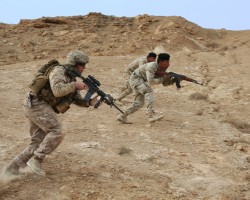
6 Key Takeaways on Confronting the Islamic State
6 Key Takeaways on Confronting the Islamic State
February 18, 2015
Today, the Obama Administration is convening a summit on countering violent extremism. Representatives from more than 60 countries are meeting to discuss ways to prevent radicalization and terrorism. The summit illustrates that fighting terrorist groups like the Islamic State is about more than military strategy in Iraq and Syria. As Maj. Gen. Paul Eaton (Ret.) notes in NSN’s new report, Confronting the Islamic State: An Assessment of U.S. Strategic Options, “the choices facing policymakers are characterized by problems far more complex than fine-tuning a military strategy and the question of boots or no boots on the ground. Counter-ideology, diplomacy, economics, and politics at home and abroad all play a role.” Nonetheless, most current strategic proposals are focused largely on the military dimension, with some plans risking drawing the United States into an unwinnable quagmire and others offering realistic approaches more likely to achieve U.S. strategic objectives. After analyzing over 20 separate strategy proposals, here are 6 key takeaways from NSN’s report:
The debate on how to confront the Islamic State is being distorted by a handful of analysts proposing extreme measures. Only a few analysts, many of them the same neoconservatives that encouraged the invasion of Iraq, have advocated the full entry of the United States into the Syrian civil war. These proposals have received outsized political attention and been amplified by powerful hawks in Congress, but they do not represent the collective wisdom of experts.
The most extreme proposals would effectively adopt the Syrian civil war, committing the United States to a possibly unwinnable fight in which it has no vital interest. The United States’ only vital interest in fighting the Islamic State is preventing transnational terrorist attacks. But these expansive strategies would commit the United States to standing up and supporting a large force of unproven Syrian rebels who do not share U.S. priorities. This would escalate and prolong Syria’s civil war and commit the United States to supporting the Syrian opposition not only in its fight against Assad, but in its fight against other rebel factions after Assad falls. Meanwhile, these strategies would leave the threat from the Islamic State largely unaddressed.
The political conversation should refocus on U.S. policies to contain and degrade the Islamic State: This is where the analytical debate is really taking place. Most proposed strategies do not include considerable deployments of U.S. troops, “safe zones” in Syria, or targeting the Assad regime. Instead, most strategies suggest that the United States enact a strategy similar to the Obama Administration’s current policies. These strategies advocate that the United States provide air support and work with partner forces to degrade the Islamic State, but differ on what the United States can credibly achieve in Iraq and Syria. Some, including President Obama, have argued the United States can destroy the Islamic State, while others suggest containing the Islamic State and pushing it back as possible.
The greatest concern with the current strategy is not what the Administration is doing, but what it will do next. Despite the contentious policy debate over what the United States should do to combat the Islamic State, many experts have endorsed policies remarkably similar to the Administration’s plan. This is, admittedly, a long-term strategy, and NSN and other experts have concerns that should the success of the current strategy stagnate, the United States will escalate its involvement in Syria in counterproductive ways. Like more expansive strategies, this would commit the United States to actors in Iraq and Syria that do not share U.S. interests and could draw the United States into an unwinnable quagmire and unsustainable nation-building project.
The United States should resist conflating the Islamic State and al-Qaeda, and conflating emerging satellites of the Islamic State in places like Libya with the organization’s core in Iraq and Syria. Like al-Qaeda, the Islamic State has lent its name and credibility to sympathizers in undergoverned regions, but these groups are focused on local governance, and in the case of Libya, drawing Egypt further into a regional war. The Islamic State’s “provinces” outside of Iraq and Syria are best addressed by lessening the appeal of the organization’s core by degrading its ability to function and promote itself from Iraq and Syria, and by strengthening national institutions in the countries in which these satellite groups operate. They are primarily local actors responding to local concerns. If the United States treats these groups as transnational terrorists like al-Qaeda, though, they could well shift their strategy to attack American targets. For the present, the better strategy for the United States is to focus on disrupting the Islamic State’s operations in Iraq and Syria to undermine the credibility these groups derive from the organization’s name, while working with local partners to strengthen governance.
The United States must pursue a comprehensive strategy that confines the Islamic State both geographically and in its military and governmental operations. After our assessment of the proposed strategies, NSN concluded that the best and most realistic option for the United States is to pursue a strategy that 1) halts the geographic spread of the Islamic State (“Horizontal Containment”), 2) constrains and degrades the Islamic State’s political, economic, and military power and institutions, including its ability to disseminate propaganda (“Vertical Containment”), 3) pushes the Islamic State out of Iraq and work with partner ground forces in Syria that can act as wedges to break the Islamic State’s territorial control where possible (“Selective Rollback”), and 4) pursues a peaceful resolution to the Syrian civil war through leadership- and local-level diplomacy. We call this “Containment Plus.”



![A U.S. Marine leads a group of Iraqi soldiers through a fire and maneuver course at Al Asad Air Base, Iraq [U.S. Marine Corps Photo by Cpl. Carson A. Gramley/ Released, 1/28/15]](/cms/assets/uploads/2015/02/Confronting-the-Islamic-State-Cover-Photo-140x140.jpg)